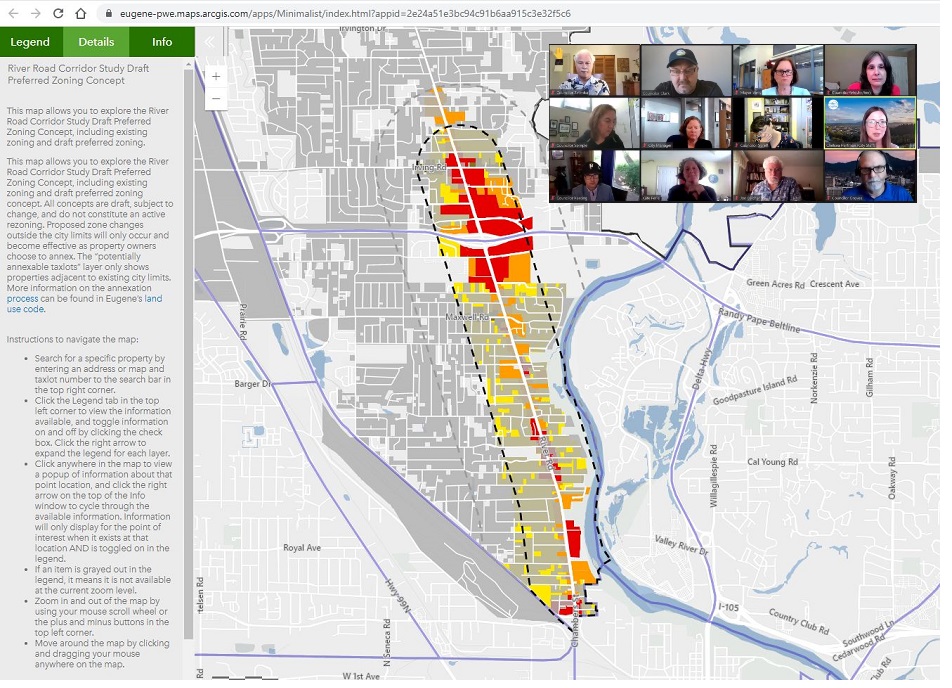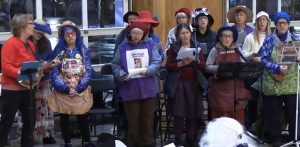River Road – Santa Clara plan represents new planning paradigm for Eugene
6 min read
The River Road / Santa Clara plan represents a move away from neighborhoods and towards planning districts, according to the City's Chelsea Hartman and Terri Harding.
For the River Road / Santa Clara neighborhood plan, Kate Perle, Community Advisory Committee co-chair.
[00:00:07] Kate Perle: Our River Road – Santa Clara Neighborhood Plan is going to guide our neighborhoods for decades to come, in terms of growth, development, and change.
[00:00:15] John Q: Kate said the plan represents a major shift by the city, from planning by neighborhood to planning by area.
[00:00:22] Kate Perle: Moving forward, we’re going to do planning by area instead of just by neighborhood. And we just happened to be two neighborhoods that make up one of those planning district areas.
In the past, most refinement plans or neighborhood plans have been primarily land use plans. And this plan as a neighborhood plan is far more diverse than that, right? We have economic development, which generally doesn’t lie in other neighborhood plans, and natural resources, and it’s such an enormous landmass that we’re planning for, that it’s not possible to implement the plan fully at the time of plan adoption, because it’s so wide-reaching and so far-reaching over time. This isn’t a typical one-and-done plan. We’re going to need to collaborate over the next 30 years with the County and the City to make all the different aspects of the plan come to fruition.
[00:01:20] John Q: To get to this point, the group has already been collaborating for 20 years.
[00:01:25] Kate Perle: We’ve been two decades in the making before we even initiated this plan, River Road and Santa Clara, we’ve been working together, reaching out to our neighborhoods, trying to find out what our neighbors value and how they want their future to look.
Thank you for supporting
local civic journalism
In 2019, the City Council and the Board of County Commissioners approved our draft goals and policies. And since then, we’ve been focusing on actions to implement the policies. We have what we call the Action Plan, and we also have themes and some of these themes are equity and inclusion, connectivity, healthy people and climate, safety, prosperity, and neighborhood identity.
[00:02:07] Chelsea Hartman: The city is anticipating shifting toward a planning district approach to support coordination of a variety of our efforts while working for more equitable outcomes throughout Eugene.
Key code themes include a vibrant, mixed-use corridor to support 20-minute neighborhoods; transition and compatibility standards; Willamette Greenway overlays to provide standards for development adjacent to the river; and increasing opportunities for urban agriculture and animal keeping. We’re also discussing possible ways to connect the River Road Corridor Study concepts and the Middle Housing Code Amendment efforts, for example, piloting ideas to encourage middle housing within walking distance of River Road.
[00:02:51] Councilor Mike Clark: Thanks to Kate, Chelsea, to Jon, I saw some faces of friends in there too. I saw Jerry Finigan and Ed McMahon. I saw Ann, of course, in there too, and those in the Santa Clara area who have spent a lifetime of investment in the area, I want to appreciate them out loud as well…. all the members of the community out there who worked on this as well, longer than I’ve been a councilor. So I know the investment. I’ve seen it over time. I remember listening to Kate before I was a city councilor talking about the importance of this work at Santa Clara Community Organization meetings.
And I, I admired, wait, what did you say every other, every other week for four years? Is that what you said? You guys meet regularly to go through this? Holy cow, I, you know, we think we have a lot of meetings. These guys have been working hard for a very long time, and I honor both the process and the work that you’ve done and am in full support of the plan and what you’re doing.
I had just a couple of questions. Are we incentivizing not-annexing in any way that you’re aware?
[00:04:03] Jon Belcher: I can’t think of anything, Mike, the only thing that comes close is the County allows ADUs to be built now without annexing, but that’s not us. (Right.) There’s nothing that I can think of. You still have to annex in order to develop.
[00:04:19] Councilor Mike Clark: Chelsea, you mentioned the ongoing process, the monitoring and the collaboration work that will be done as new issues arise in time. Can you talk in more detail about that resolution process?
[00:04:32] Chelsea Hartman: The overall citywide growth monitoring can help us see how we’re measuring and meeting those outcomes that are identified in the plan. We’ll be looking at what metrics might be out there.
[00:04:43] Councilor Mike Clark: If, for example, the City or the County were implementing something in conflict with the plan, how would that resolution, how would that collaboration look?
[00:04:53] Chelsea Hartman: Once it’s adopted, the policies will provide the official City and County policy direction for primarily land use decisions in this area. And we’ll still have that community accountability side of things, advocates continuing to push things forward.
[00:05:08] Councilor Mike Clark: What does that look like, advocates?
[00:05:13] Chelsea Hartman: I think it’s something we’re still figuring out. I looked at Kate— do you have thoughts on this one?
[00:05:18] Kate Perle: Ongoing advocacy looks like people from the community organization looking at the plan, looking at ongoing projects from the City and the County, and then coming to decision-makers saying, ‘Okay, well, so these were the items in our action plan that have been identified as important to the neighborhood that’s in this adopted plan.’
[00:05:38] Councilor Mike Clark: Chelsea, let’s say we have to increase density. We have to double in a particular area of this plan. How would we work with that? How would we resolve that together?
[00:05:51] Chelsea Hartman: Um, I think it would probably be similar to what the Middle Housing amendment process is looking like now, and exploring what changes would have to occur. So one of the things we’re hoping to do with the neighborhood plan is a Special Areas Zone.
[00:06:07] Councilor Claire Syrett: I just wanted to ask Chelsea, if you could elaborate a little bit on this planning district concept.
[00:06:13] Chelsea Hartman: Our general hope is that we can break up the city into larger areas that we do coordinated planning. So, so far we’ve talked across the Land Use Planning team, Transportation Planning, and Parks Planners, and just trying to figure out how we can better coordinate each of our, um, topic areas and work towards these community visions in these areas and working with the broader community. River Road and Santa Clara is about a fifth of Eugene. So that’s already a huge area and it aligns well with the Parks Neighborhood Planning District boundary, as well as Bethel.
[00:06:53] Terri Harding: Well said, Chelsea, I would just echo that, recognizing the shift from neighborhoods-based planning that we did a lot of in the ’70s, ’80s, and ’90s, to more of an equitable approach by larger district of the City, is the direction that planning is going nationally.
[00:07:13] John Q: Councilor Claire Syrett liked involving more than one neighborhood.
[00:07:17] Councilor Claire Syrett: You know, they’re an important component of the work, but not the only component….I doubt that we would have had hundreds of people participate if it had been strictly about land use code, but the fact that we were offering people an opportunity to create a vision that included, a myriad of things that they relate to as being part of a neighborhood part of a community beyond just, what are they allowed to do on their property? I think really inspired people to participate.
[00:07:52] Councilor Alan Zelenka: Kate and Jon, thank you for doing this and shepherding this through and your patience and commitment. This is a long time coming, but it’s a really good plan and I really love that it does go, as Kate said, beyond just land use. I totally appreciate all of the neighbors’ stick-to-it-iveness in getting this done. Unfortunately, I think for other neighborhoods, you guys have set the bar pretty darn high for collaboration and working through a plan.
[00:08:24] Councilor Jennifer Yeh: I move to initiate a public review and adoption process for the River Road – Santa Clara Nighborhood Plan, including associated Comprehensive Plan and Refinement Plan amendments, zone changes and Group One land use code amendments.
[00:08:40] Mayor Lucy Vinis: All in favor, five, six, seven, and we’re missing one person. So that passes. Thank you very much. I really, I think we are all so excited about this work and proud of all of you volunteers and staff alike who have brought us to this point.
[00:08:59] John Q: The public review and adoption process continues.





